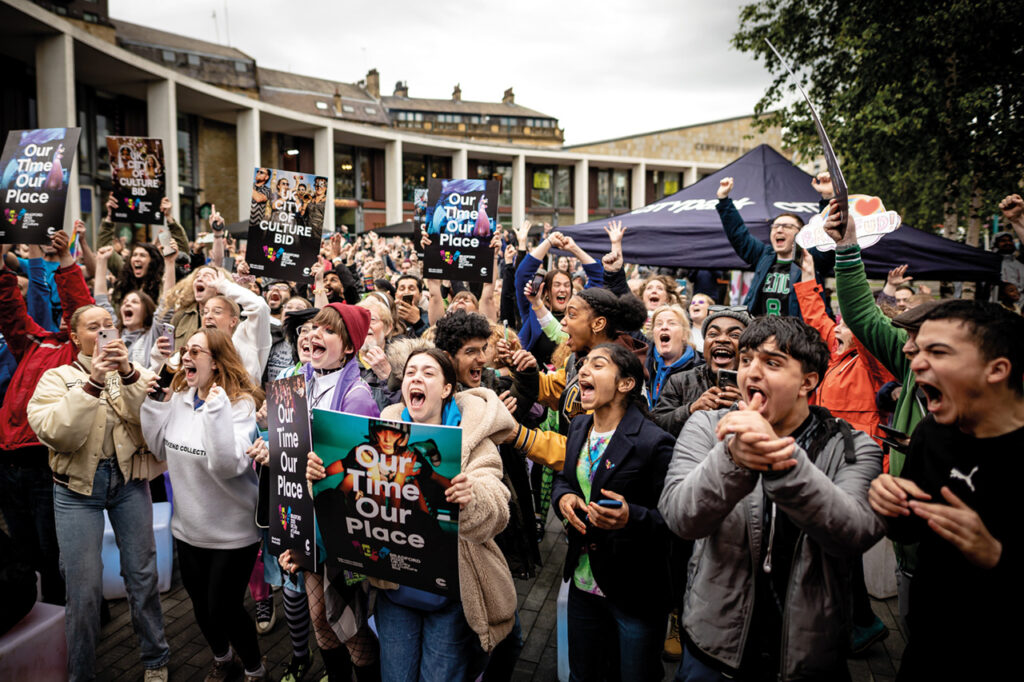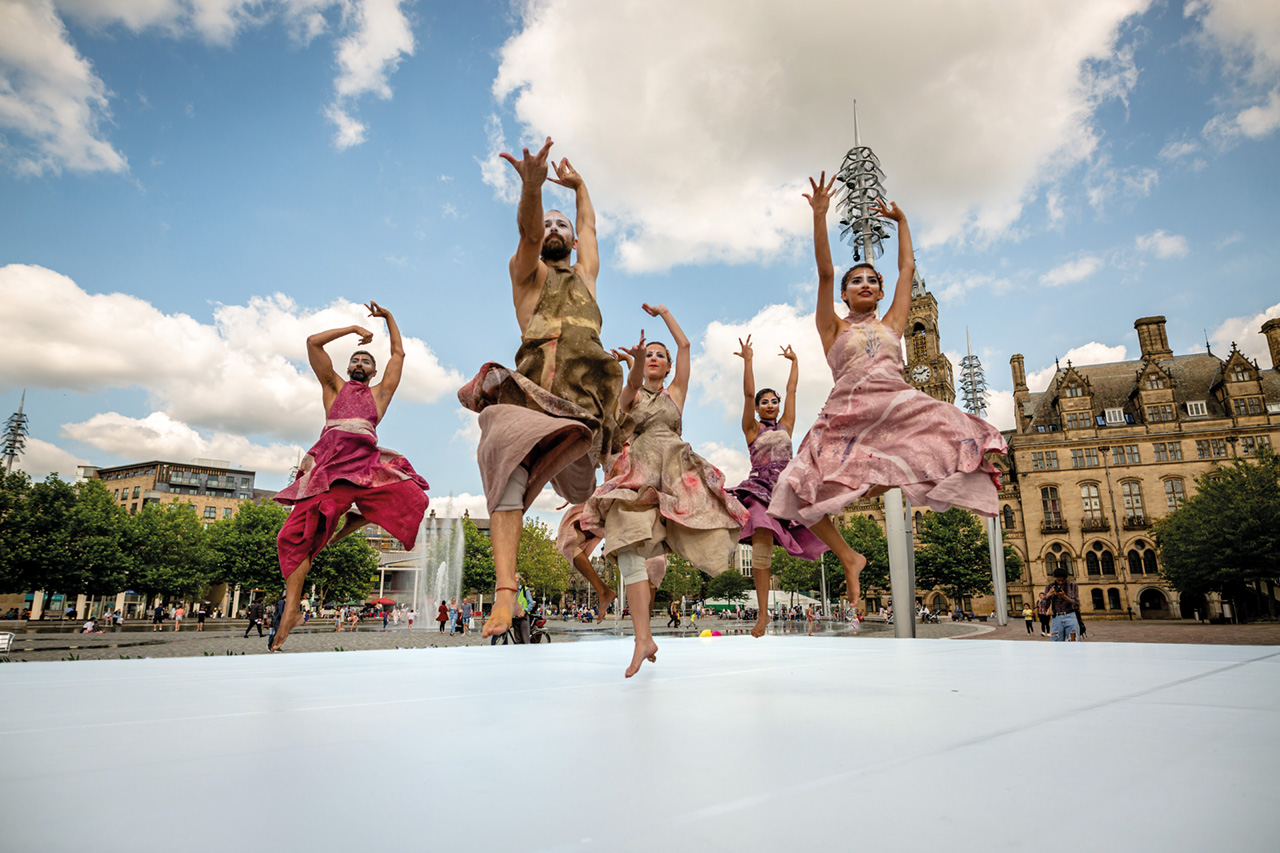Dancing in the city
Bradford will follow in Hull’s footsteps when it becomes UK City of Culture in 2025. But can the year-long arts programme really deliver long-term change for those who host it?
Whenever he is asked what UK City of Culture status means for Bradford, Kamran Rashid turns to an old Indian proverb.
“Until the lion learns to tell its story, the hunter will always be glorified,” says the CEO of the Impact Hub, which was set up to nurture social enterprise in the West Yorkshire city. “That perfectly sums up this city. Bradford is a lion, but one that has been sleeping. It is now time to tell our own narrative.”
Rashid played an integral role in Bradford’s successful bid to secure UK City of Culture status for 2025. Bradford plays host to a 12-month programme of 1,000 new music, arts and theatre events, which, according to its champions, will secure a platform for wider economic regeneration.
“Right now, it feels like Bradford is at a tipping point,” says Rashid. “There is so much potential here, not just in the heart of Bradford itself but across the whole of the district. Becoming the next UK City of Culture will allow us to both improve the physical infrastructure of the city and build the confidence and self-esteem of the people of Bradford.”
The project is a spin-off from the European City of Culture initiative and the ambitions Bradford has for 2025 were also true of Hull when it enjoyed its year as UK City of Culture in 2017.
Paul Smith, co-founder and artistic director of the renowned Middle Child theatre company, remembers the sense of excitement well.
“From the day of the announcement Hull just seemed electrified and for us personally it made a huge difference,” he says. “We got more attention from the press than we had ever had before and were given not just funding but a level of permission to do things that without City of Culture would have taken us at least five years to green light. It basically pushed the fast forward button.”
Middle Child is known for its gig theatre and its 2017 show, All We Want Is Everything, which weaved everything from Cool Britannia to Brexit into a tale of an asteroid on a collision course with Earth. It transferred to the Edinburgh Fringe, where the company enjoyed its biggest ever audiences.
The following year Middle Child was made one of the Arts Council’s National Portfolio Organisations, which means guaranteed funding. But Smith remains cautious about the word “legacy”.
“Lots of good came from that year and not just for us,” he says. “Just like the Olympics in 2012, volunteers were a key part of delivering Hull 2017. It gave rise to a real collective spirit and that is still very much in evidence.
“However, City of Culture is not a silver bullet, nor should it be. Pinning down the legacy is difficult, impossible even, and I do wonder whether people sometimes expect too much from these events.”
There were, though, some concrete wins for Hull. Back to Ours, an organisation dedicated to making the arts more accessible, was founded as a result of the event and figures showed that between 2013 and 2019 an estimated £676 million worth of new public and private investment in Hull could at least be partly attributed to the UK City of Culture.
However, research from the University of Hull also acknowledged that trying to build a legacy on the back of 2017 was a challenge and claimed the “project arguably did not give a sufficiently high priority to legacy and citywide cultural strategy considerations”.
Richard Shaw, director of Bradford’s bid, is too diplomatic to get drawn into any criticisms of its Northern neighbour. However, he is keen to point out that Bradford 2025 is just one part of a 10-year cultural strategy, during which the district will benefit from a number of major cultural capital projects, including the transformation of the city’s historic Odeon building into a new 4,000 capacity music venue and the £23 million flagship development of Darley Street Market, which will also boast a smaller 750-capacity venue.
“Legacy has to be at the forefront of a project like this,” insists Shaw. “City of Culture can’t just exist in isolation – it has to be used as a catalyst for change and I am confident that 2025 will be just that.
“We spent two years listening to people in Bradford about what they wanted and what they needed and the bid was theirs, not mine.
“Of course there are commercial challenges but if we get this right it will be a real chance to deliver levelling up.”
It is just two months since Bradford beat off rival UK City of Culture bids from Southampton, Durham and Wrexham, but those working in the creative sector say it has already started to deliver results.
The Mills Are Alive, where earlier this year former mill buildings were used as blank canvases for light projections, and last summer’s Rite of Spring, an outdoor reimaging of Stravinsky’s famous ballet in City Park, demonstrated a depth and breath of talent.
They also point to the £2 million secured by the community-led arts programme the Leap and the £1.5 million invested in the Bradford Producing Hub (BPH) – a four-year pilot project dedicated to developing local creative talent.
Launched in 2019 it is likely that the latter will continue to exist in some format in the run-up to 2025. However, if it has done its job, hub director Lisa Mallaghan should soon have made herself redundant.
“Running an arts development project during a global pandemic hasn’t been easy, but in some ways it worked in our favour,” she says. “With theatres closed, work had to find new venues outdoors and that DIY approach can be really inclusive.”
To date, BPH has trained more than 1,000 individuals in everything from writing funding applications to artistic research and development, commissioned £250,000 worth of projects and seen that work tour locally, nationally and internationally. It has also set specific – and ambitious – targets for 2025.
“Previous UK Cities of Culture have boasted that a third of the talent used to stage the year was local. For Bradford I don’t think that is good enough,” says Mallaghan. “We have set a target of 50 per cent and we now need to be clearly focused on fast-tracking the talent that we have.
“It is partly about giving people easy access to funding streams, but it is also about collaboration and encouraging those already established to work with complete newcomers. What we want is for everyone to realise their artistic potential.”
By way of example, Mallaghan points to Kauser Mukhtar. By her own admission she is a middle-aged single parent who up until two years ago had never made a single piece of art.

“I didn’t go to the cinema until I was in my twenties,” admits the former science teacher whose parents moved to Bradford from Pakistan. “When I had my own children I was really conscious that they should have a cultural education as well as an academic one.
“I took them to the theatre as often as I could and it was there that my own creativity was sparked.”
After watching a production staged by Bradford’s Cecil Green Arts, which specialises in puppetry, Kauser had her own idea for a show inspired by a South Asian folk song she listened to as a child.
“I had a vision but that was it,” she says. “The whole process of writing and directing a show was an alien concept and without BPH it would have stayed as a dream in my head. However, they paired me with an established director who was really encouraging and who showed me how to turn my idea into a show.”
Khooghi premiered in 2020 and after a successful run is now being developed by Kauser with the aim of taking it into schools across the Bradford district and beyond.
“There are a lot of negative stereotypes about the Pakistani community in the UK,” she says. “Bradford 2025 is a chance for us to rewrite those stories and make them our own.”
That same sentiment is shared by Rashid, who says he has already witnessed first hand the potential power of the UK City of Culture brand.
“People used to ask, ‘Do you remember where you were the night of the Manningham riots?’” he says, referring to the 2001 violence that erupted between white and Asian communities, and cast a long shadow over the city.
“Now I have heard people asking, ‘Where were you when Bradford was named City of Culture?’ There is a bounce in people’s walk and we must capitalise on that.
“We must put our shoulders back, our chin up and our chest out. We must recognise we have a story worth telling.”
If Bradford 2025 can achieve that, its legacy will be priceless.

Leave a reply
Your email address will not be published.